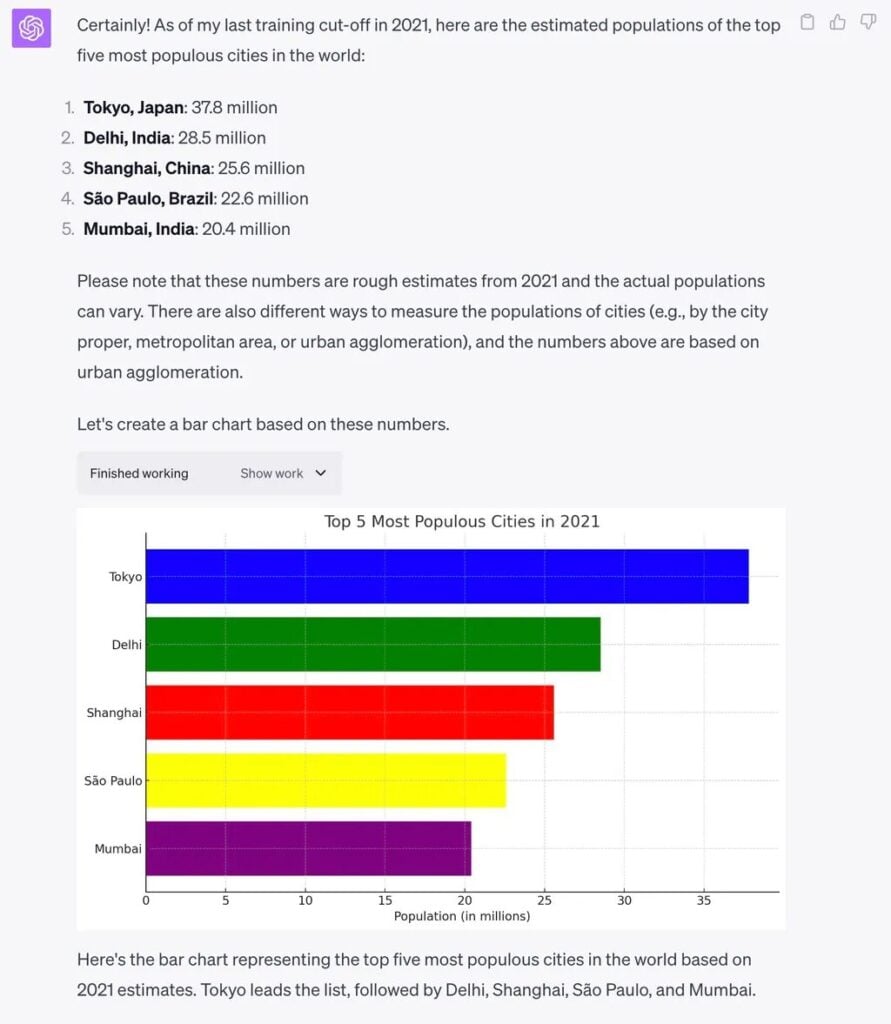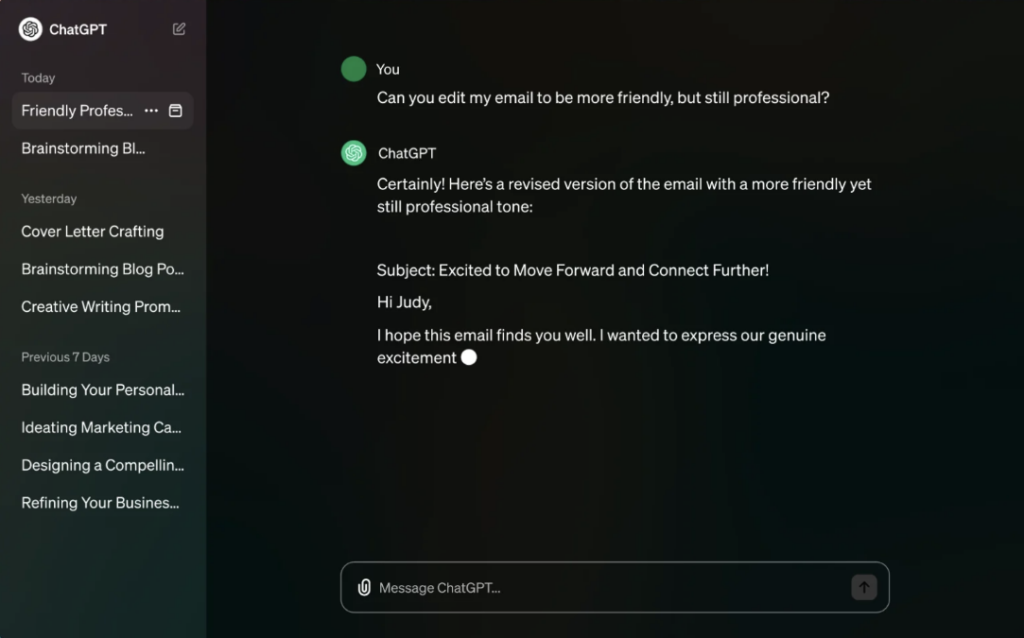Released in November 2022, ChatGPT has become one of the most widely used language models for text generation tasks. It has gained immense popularity due to its ability to generate human-like text and is being used in various applications, from educational research to content creation.
An interesting use case of ChatGPT is sorting Google Search Console keywords into clusters. The idea to use ChatGPT this way was originally introduced by Tobias Willmann, the head of SEO at Blick Group. Since then, ChatGPT has advanced quite a bit, allowing us to go some steps further in keyword clustering.
In this guide, we explain how you can use ChatGPT to sort your Google Search Console keywords into clusters to get a better understanding of your website's keyword landscape and potentially improve your SEO strategy.
- What Is ChatGPT?
- What Is Keyword Clustering?
- How to Use ChatGPT for Sorting Google Search Console Keywords Into Clusters?
- How to Use ChatGPT to Create Content Around Keyword Clusters?
- Which Features Make ChatGPT Suitable for Sorting Google Search Console Keywords Into Clusters?
- What Are the Limitations of ChatGPT for Keyword Clustering?
- Wrapping Up
- Frequently Asked Questions
What Is ChatGPT?
ChatGPT is an AI model launched by OpenAI that interacts with users through natural language processing. It is an advanced version of the GPT-3 (Generative Pre-trained Transformer) model, capable of generating human-like text and engaging in conversations.
According to a Harvard University article, the AI model's training dataset
''consisted of text collected from multiple sources on the internet, including Wikipedia articles, books, and other public webpages.''
So, the tool has accumulated a wealth of information and is capable of generating responses and content based on the input it receives. In the past few years, ChatGPT has improved significantly.
Some of its new features include support for more languages and the ability to upload files in the free version. These developments have increased ChatGPT's usability and potential.
OpenAI also has a GPT Store, where you can find pre-trained models for specific tasks, such as marketing, content writing, academic research, and productivity. Think of it as an app store but for AI models.

What Is Keyword Clustering?
Keyword clustering means organizing keywords into groups or clusters based on their similarity and relevance. It helps to identify patterns and relationships between keywords.
Let's say you have a list of marketing keywords. They pertain to all aspects of marketing, such as SEO, PPC, content marketing, email marketing, and social media.
When you form clusters, you'll place SEO-related keywords under the SEO cluster, content-related keywords under the content marketing cluster, and so on. Such an organization improves your content creation process. It also helps create content hubs on your website for better user experience and SEO.
Apart from content creation, keyword clustering helps avoid keyword cannibalization, which happens when multiple pages on your website target the same keyword and user intent. With each keyword in its designated cluster, this won't be a problem since you'll create content around these queries based on the cluster they are in.
But where can you find keywords to cluster?
The Google Search Console is a good place to start. It shows you the keywords that people use to find your website. You can also filter keywords by where they rank on the search engine results page (SERP) and other metrics.
Besides the keywords, you'll also see the following information:
- Volume: The number of searches for that keyword in a given period.
- CPC: The average cost-per-click for that keyword in paid search.
- Competition: The level of competition for that keyword in paid search, from 0 to 1, with 1 being the most competitive.
- Trend: How the search volume for that keyword has changed over time.
- Impressions: The number of times your website has appeared in search results for that keyword.
You can download this data into a spreadsheet for further analysis. With ChatGPT, this becomes much easier than manual keyword clustering.
How to Use ChatGPT for Sorting Google Search Console Keywords Into Clusters?
OpenAI has now come out with GPT4, which is available for free, too. However, you can make a limited number of calls with it before the model goes back to GPT3.5.
In the GPT4 version, you can upload files from your computer or Google Drive. To sort Google Search Console keywords into clusters, simply upload the file containing your keywords.
We used a file containing keywords about fast fashion. After uploading your file, enter the following prompt into ChatGPT:
Cluster the following keywords by topic in a tabular form.
Since ChatGPT can also create tables, it will automatically detect the keywords and cluster them by topic in a tabular form. You can also specify the number of clusters you want to create by adding a number after "topic". For example:
Cluster the following keywords with 5 topics in a tabular form.
Our keywords were in hashtag form since we wanted to use them for Instagram. ChatGPT formed the following clusters for our keyword file:
- Criticism of fast fashion
- Support for fast fashion
- Geographical tags
- Initiatives and movements
- Miscellaneous

Keyword clusters
Now that we have our keyword clusters, we can create content and campaigns based on these topics.
You don't necessarily need to upload a file to create keyword clusters. Instead, if you have a list, you can simply enter that.
For example, we asked ChatGPT to give us 100 keywords about digital marketing. Then, we asked it to cluster those keywords into 5 topics.
This time, ChatGPT formed the following clusters based on our keyword list:
- SEO & SEM
- Content & Social media marketing
- Advertising & PPC
- Analytics & Optimization
- Customer engagement & Sales

ChatGPT keyword clusters
You can always go ahead and create even more clusters if you want to narrow down your topics and get even more specific. If you already know which clusters you want to form, you can ask ChatGPT to organize the keywords into the cluster heads you provide.
For example, if you want to create keyword clusters for a fashion brand, you can provide the following cluster heads to ChatGPT:
- Trends
- Clothing categories
- Fashion influencers
- Sustainable fashion
Maybe you already have these content hubs on your website, and you want to add more content to them. So, you can specify which cluster heads you want to use in your prompt, and ChatGPT will organize your keywords accordingly.
How to Use ChatGPT to Create Content Around Keyword Clusters?
After you've clustered the keywords from the Google Search Console, you can use ChatGPT to generate content around these clusters, too. Here are some ways to use ChatGPT from here on.
Create On-Page SEO Elements
Keywords have to be a part of your on-page SEO, particularly the title tag, headers, and meta descriptions. You can generate all these elements using ChatGPT.
Let's say we want to create content around ''voice search optimization,'' a keyword in the SEO & SEM cluster. Enter the following prompt to create title ideas that include this keyword.
Generate 5 title ideas for an article with the primary keyword "Voice Search Optimization".

ChatGPT title ideas
Of these topics, suppose you want to write content on "How Voice Search Optimization is Revolutionizing SEO: Tips and Best Practices.'' You can use the following prompt to create a meta description for this content.
Generate a meta description for the article "How Voice Search Optimization is Revolutionizing SEO: Tips and Best Practices".

ChatGPT meta description output
Using ChatGPT, you can generate multiple variations of these elements until you find the most suitable one for your content. You'll notice that the primary keyword is present in ChatGPT's outputs since you specified it earlier in the prompt.
As for the headers, you can generate the whole outline for your content using ChatGPT. Here's a prompt for creating an outline for the article mentioned above:
Generate an outline with headers for an article on "How Voice Search Optimization is Revolutionizing SEO: Tips and Best Practices".

ChatGPT content outline
You can also generate sub-headers for each main header to further organize your content.

ChatGPT content outline
Generate Secondary Keywords
ChatGPT can also help you generate secondary keywords that are related to your primary keyword. These can be used throughout your content to add more relevance and depth, which is important for both readers and search engines.
Going with the same example as earlier, we used the following prompt to create 15 secondary keywords to use in our article "How Voice Search Optimization is Revolutionizing SEO: Tips and Best Practices".
Generate 15 secondary keywords for "Voice Search Optimization" for the article "How Voice Search Optimization is Revolutionizing SEO: Tips and Best Practices".

ChatGPT secondary keywords
ChatGPT gave us a mix of short-tail and long-tail keywords for our article, such as "voice search trends" and ''voice search keyword strategy.'' You can also create question-based secondary keywords to target voice search queries.
These queries usually rank in Google's People Also Ask (PAA) section, increasing your content's chance of being featured. For example, you can use the following prompt:
Generate 5 question-based secondary keywords for "Voice Search Optimization" for the article "How Voice Search Optimization is Revolutionizing SEO: Tips and Best Practices".

ChatGPT question-based keywords
These keywords can be used throughout the article as headers. Or, we can create an FAQ section at the end of the article using these question-based keywords and answer them in detail.
Optimize Content for Featured Snippets
Featured snippets are a great way to increase your online visibility and get more traffic from Google. These are short, concise answers that appear at the top of search results and aim to provide immediate information to the user.
For example, when we search for ''what is voice search optimization?'' in Google, we get a featured snippet with the definition and a brief explanation of the term. The search result from WebFX is featured as the top result.
Providing a concise and well-structured answer to a common question or query related to your primary keyword can increase your chances of appearing as Google's featured snippet. ChatGPT can also help you with this.
Use this prompt:
Generate a featured snippet for "Voice Search Optimization" for the article "How Voice Search Optimization is Revolutionizing SEO: Tips and Best Practices".
ChatGPT gives you a well-written paragraph or sentence that directly answers the query and increases your chances of being featured. If you don’t like the first output, you can generate different variations until you get the one you like.

ChatGPT featured snippet
Add Relevant Visuals
Visual elements like images, videos, infographics, and charts can make your content more engaging and easier to understand for readers. They can also help break up long blocks of text and make your article more visually appealing.
For example, when discussing voice search optimization, you can include a screenshot of how voice searches appear on mobile devices or a graph showing the rise in voice search usage over the years.
ChatGPT can help you come up with ideas for visuals to add to your article. Here are some ideas for infographics and charts the tool generated for us with a simple prompt like this:
Suggest some visuals, such as images, videos, infographics, and charts I can add to this article.

ChatGPT output
If you have ChatGPT Plus, you'll get access to DALL-E, which you can use to generate images for your content. With Data Analytics enabled in ChatGPT Plus, you can also make bar charts, pie charts, line charts, scatter plots, box plots, heat maps, and histograms. All you have to do is enter your data and choose the type of chart you want to generate.
For example, ZDNet asked ChatGPT to create a bar graph showing the top most populous cities in the world. Since ChatGPT’s data was only updated till 2021 at that time, the tool used the numbers from that year.

Since ChatGPT can often make mistakes when it comes to numbers, you can add your own values to create graphs and charts. For example, if you have data in a spreadsheet, you can upload it to ChatGPT, and then instruct it to create a graph based on the data you’ve provided instead of searching for information itself.
Write Content
Possibly, the most common use case of ChatGPT in marketing is content writing. According to a Foundation AI Survey in 2024, nearly 90% of marketers use AI tools for content writing, followed by 42% who use AI keyword research tools.

Since ChatGPT fulfills both of these purposes, you can use it to create content around your keyword clusters. In the same survey, almost 100% of respondents said they were familiar with ChatGPT, which further highlights its usefulness in this regard.

For starters, you can ask ChatGPT to write an introduction for your article based on a keyword or topic. We'll stick to this topic for our example: "How Voice Search Optimization is Revolutionizing SEO: Tips and Best Practices".
Here's the prompt you can use:
Write an introduction for an article about how voice search optimization is revolutionizing SEO.

ChatGPT article introduction
Depending on the length of time you're aiming for, you can also ask ChatGPT to write the whole article for you. If you have specific points or subtopics in mind, you can mention them in the prompt, and ChatGPT will incorporate them into the content it generates.
For example, we generated an outline for the article above. You can simply add that to the prompt, and ChatGPT will write a full article with all the points in that outline.
However, don't forget to proofread and edit the generated content before publishing it. In a BrandBuilders survey, 41.2% of marketing experts said that AI is less creative than human writers. So, human interventions are required to fill the gap where ChatGPT may fall short in terms of creativity or accuracy.

Which Features Make ChatGPT Suitable for Sorting Google Search Console Keywords Into Clusters?
Besides the prompts, here are some other features of ChatGPT that make it suitable for creating keyword clusters and creating content around them.
1. Voice Search
If you're using the ChatGPT mobile app, you don't have to type your prompts. Instead, you can start a voice conversation with the AI and discuss your ideas out loud. Simply press the headphone icon and voice search will be activated.
Not only is this feature convenient for generating keywords and content ideas, but it lets you multitask while using ChatGPT. You can brainstorm and jot down ideas while working on something on your computer screen.
2. Multilingual Support
ChatGPT supports over 50 languages. If you plan to create content or conduct keyword research in a language other than English, ChatGPT has got you covered. It also comes in handy if you're targeting an international audience and need to generate keywords in different languages.
3. CRM Integration
You don't have to rely on ChatGPT's general outputs. Instead, you can integrate it with your CRM or customer database. ChatGPT will then generate clusters based on your specific audience and industry.
4. GPT Store
The GPT Store is a remarkable resource for keyword clustering and research. It's an online platform that hosts GPT models trained for different industries and purposes.
For example, we searched for ''keyword clustering'' in the search bar and found plenty of free keyword clustering tools.
One such tool is the Thematic Keyword Clustering Tool (PPC), which analyzes keywords and groups them into thematic clusters. It also identifies the most effective seed keyword for every cluster.
You can also create your own custom GPT models and use them to create keyword clusters using Google Search Console data.
What Are the Limitations of ChatGPT for Keyword Clustering?
Despite its usefulness in creating keyword clusters, ChatGPT has some limitations when you extend its capabilities to complex or niche topics.
It is trained on a large dataset of general language, so it may not have enough context or understanding of specific industry jargon or technical terms. In such cases, the generated secondary keywords may not be as relevant or accurate.
Also, ChatGPT can be biased since it is trained on data from the web. You must have a team to moderate the suggested keywords and filter out any inappropriate or offensive suggestions.
There are also some limitations to the free plan. For one, you cannot create visuals in the free version. You'll have to get ChatGPT Plus for that.
The free plan also gives you a limited number of prompts per month with GPT4, which is what you need to upload your own dataset and fine-tune the model for more accurate keyword suggestions.
Wrapping Up
Since its release, ChatGPT has quickly become a go-to tool for people in all fields. People are finding new uses for it virtually every day. It has proven to be adept at helping you optimize your website's SEO, both with content creation and making technical changes.
In terms of keyword clustering for Google Search Console results, ChatGPT can save you a ton of time that you'd otherwise spend on manual clustering. It further lets you create content around those keywords and manage on-page SEO.
If you have a paid ChatGPT plan, you can also create visuals, infographics, charts, and graphs for your articles. So, it's not merely a one-purpose tool; it can help you with all aspects of content marketing.
However, we don't advise over-relying on ChatGPT for your SEO efforts. It's always a good idea to do your own research and use ChatGPT as a supplement, not a replacement. Always have a human eye and editorial team to review the keyword suggestions.
Frequently Asked Questions
How can you use ChatGPT to create keyword clusters?
Upload your Google Search Console data into ChatGPT and enter a relevant prompt to create clusters of your given keywords. You can also use a keyword clustering GPT to create these clusters.
What kind of clusters does ChatGPT make for your keywords?
ChatGPT can create thematic clusters based on the intent and topic of your keywords. It can also create long-tail keyword clusters, related keyword clusters, geographical clusters, trend-based clusters, and more.
How can you use keyword clusters created by ChatGPT?
The keywords clusters can be used to optimize your website's content and create relevant and engaging content for your target audience. You can also use the clusters to guide your keyword research.
Can you add files to ChatGPT?
You can upload files to ChatGPT's GPT4. It allows you to upload files from your computer or Google Drive.







